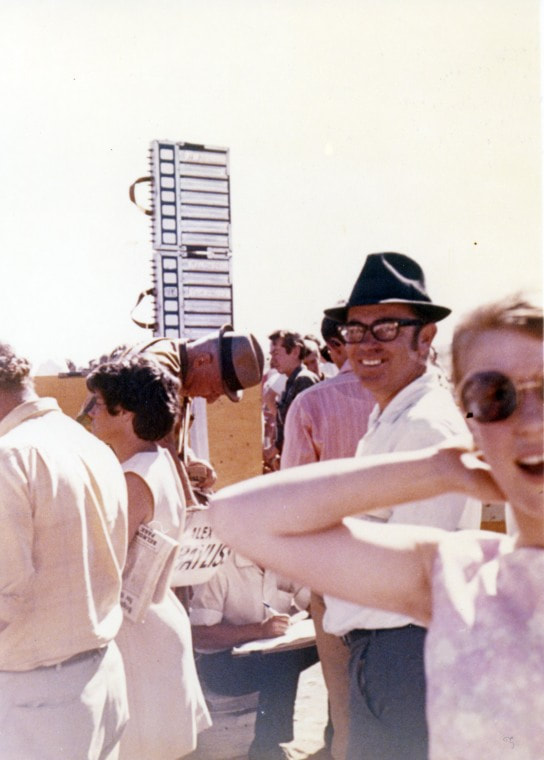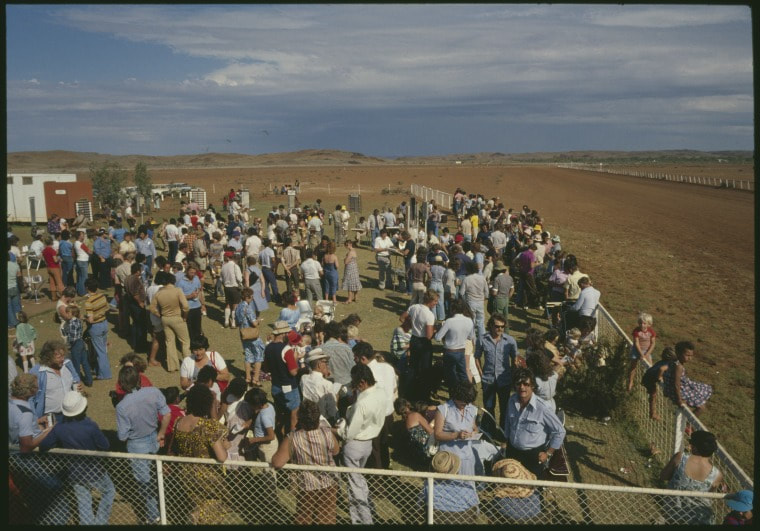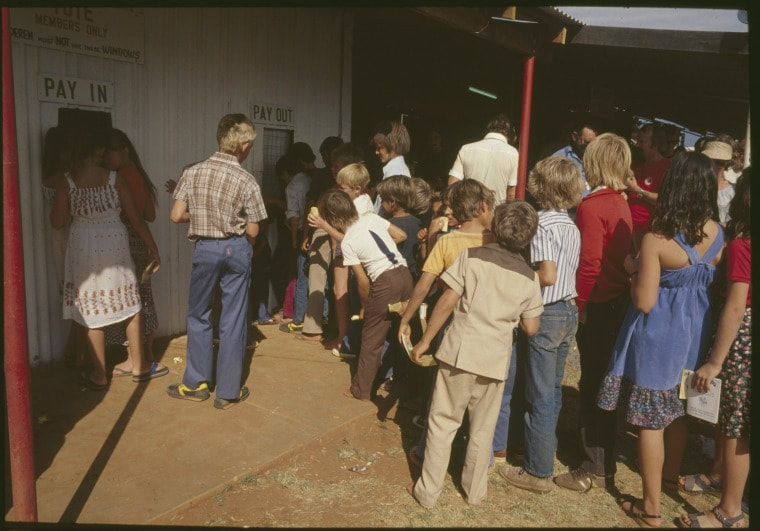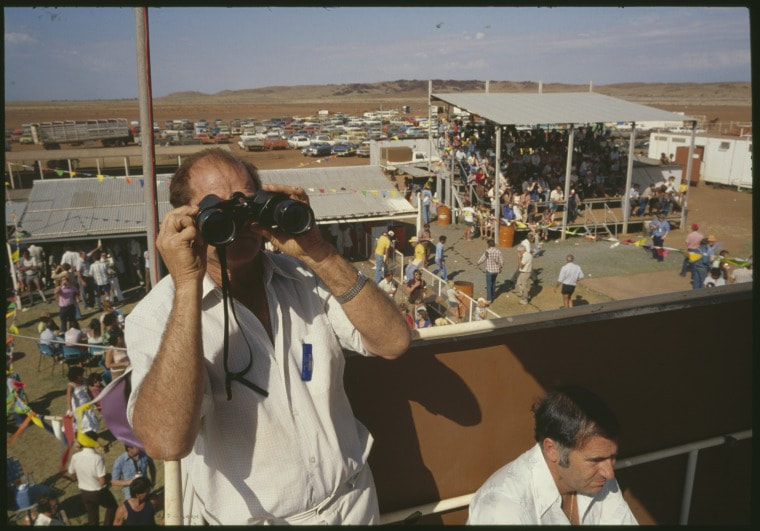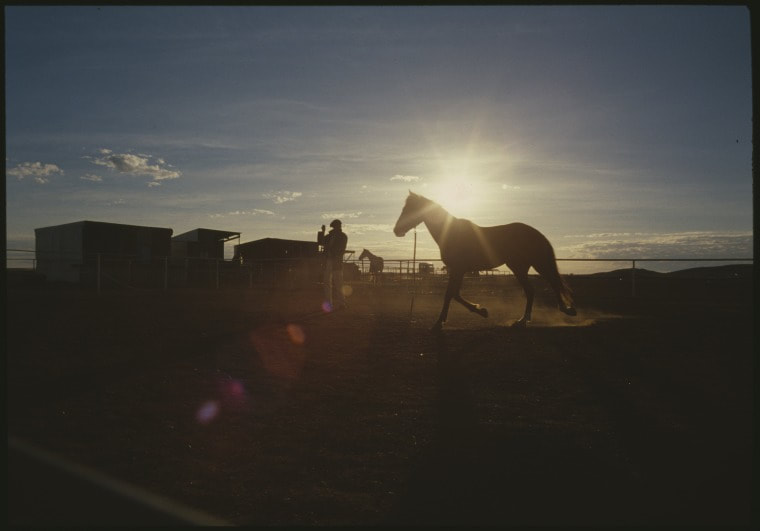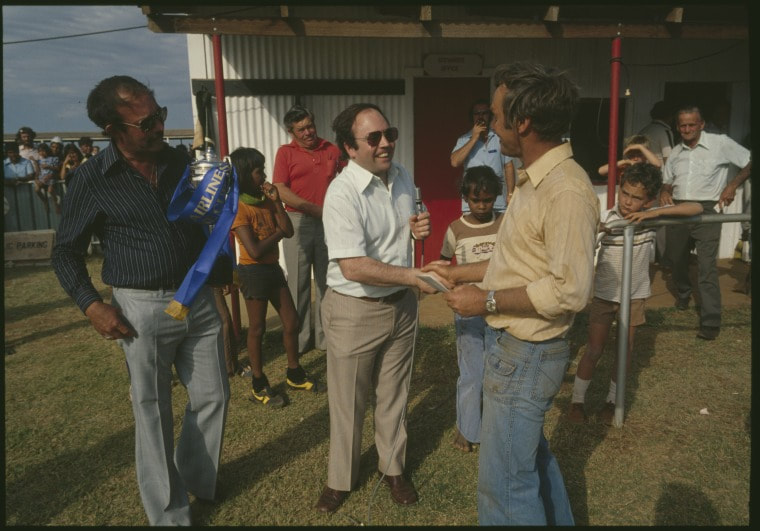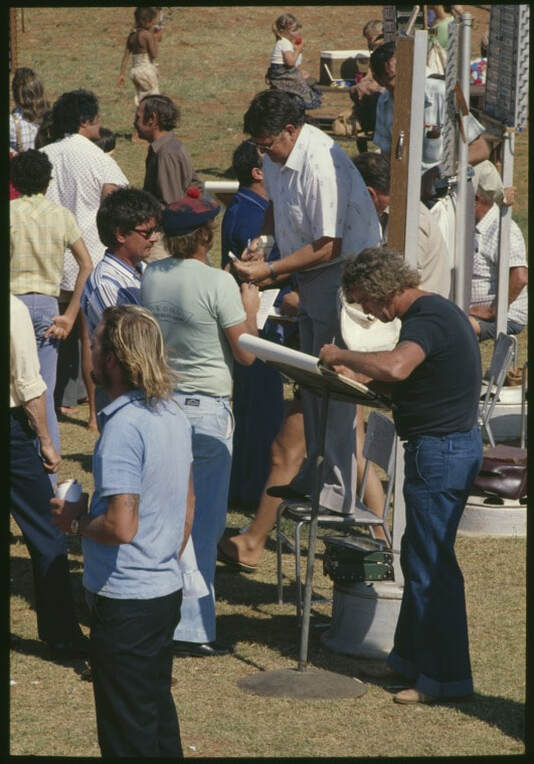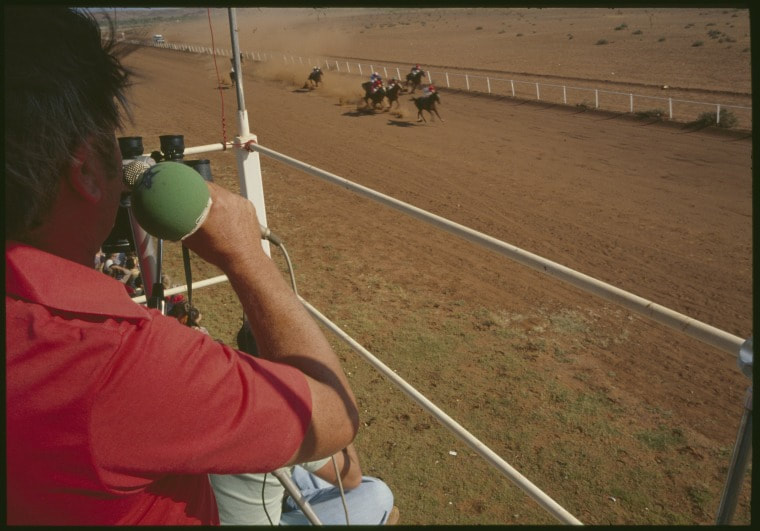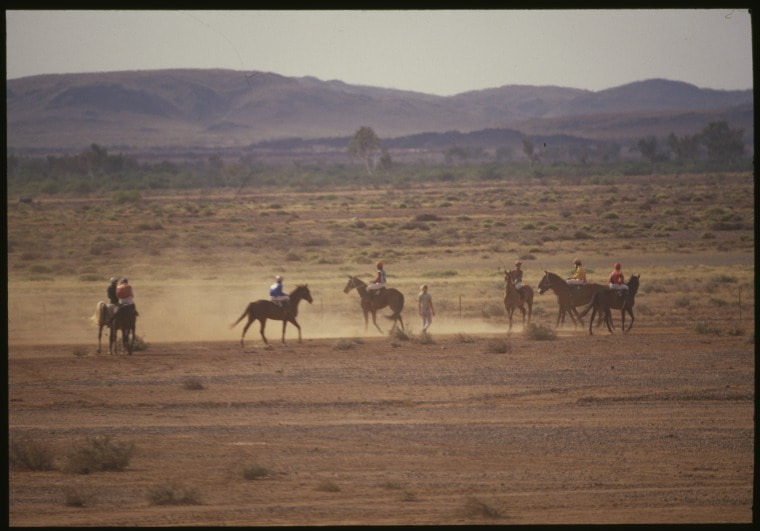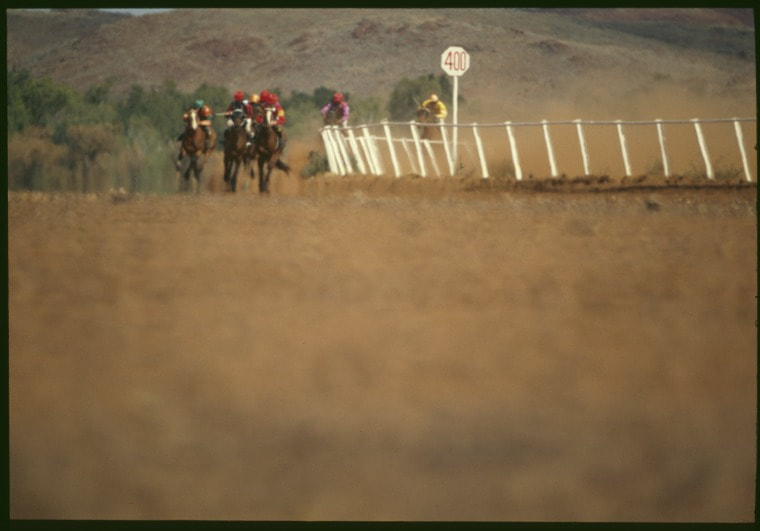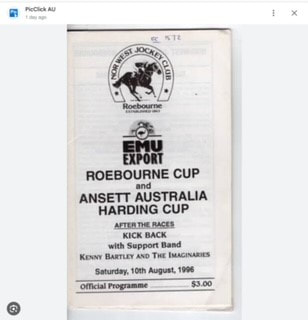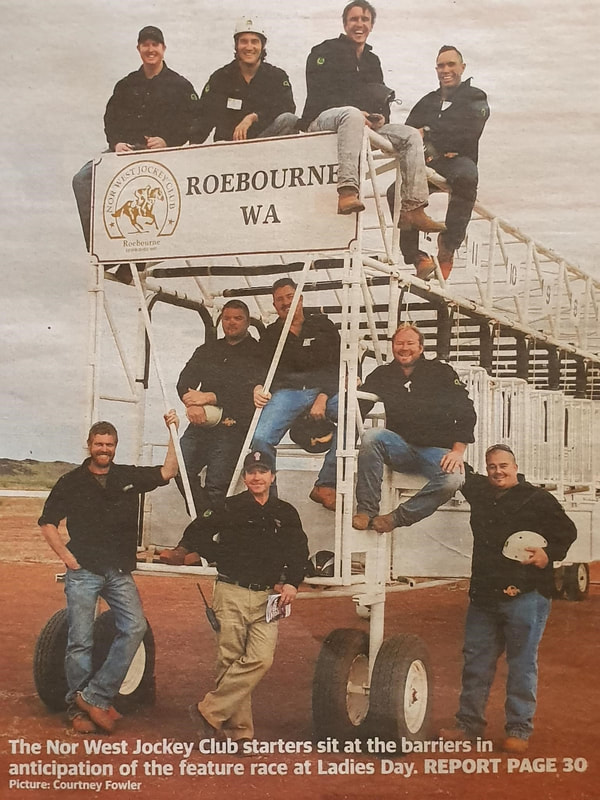|
As the story goes, during 1863 and the establishment of Cossack, a horse race was held on Settlers Beach, for the prize of a gold Sovereign coin. This began the establishment of racing in the North West.
The Nor West Jockey Club (NWJC) racecourse has been held in two locations. The races were originally held on the left hand side of the Cossack Road leading to the landing at Butcher Inlet near Cossack, before settling at the present location North of Roebourne in 1890. The NWJC has raced every year, the exception of 8 years from 1915 to 1918, 1940 to 1944 (during the World War's) and in 2020 due to COVID Horse racing started 4 years after European pioneers arrived, with the first official race meeting (run under the West Australian Turf Club Rules) held by the NWJC on the 1st August 1867 and registered on the 20th September 1867. The meeting was meant to be held earlier that year but due to there being no rain, poor conditions in the area, and a major shortage of food as they were waiting on a ship to bring supplies it had to be postponed. The inaugural winner that day was a mare call Miss Georgie, winning the Roebourne Plate (later renamed Roebourne Cup) and 15 pounds for her owner. |
|
The race meetings became important social events, with people travelling in from the outlying stations. Most of the accommodation in the town was booked out during the racing period and additional camps were set up between the racetrack and the river. The horses were ridden long distances from the outlying stations, sometimes taking 3-4 days to arrive. It was therefore important to arrive a suitable time before the races began, to allow the horses to be fully rested for the racing events; people often arrived in town up to two weeks before the actual day of the races.
The races became an annual weeklong event "Roebourne Race Week" with the Calcutta or sweeps night on the Friday, Picnincs, concerts and religious services, through to the races themselves followed by a Grand Ball for about 100 Guests. The original races consisted of four races: Roebourne Plate, Publican Purse, Scurry Stakes and Consolation Stakes. The Roebourne Plate became know as the Reobourne Cup, which is still our Major race of the year Local stations breeders were so competitive that they bred a special type of thoroughbred, dubbed the Nor West Bred Thoroughbred, several of which went on the win the Perth Cup. In 1950 the races were opened up to horses outside of the Pilbara Region, with the only stipultion being that the horses had to have been in the area for at least 3 months prior to the race. Slowly over the next 10 years the races where no longer dominated by local horses and by 1970 there was no longer a Norwest Bred Horses category which opened up the races for horses from all over australia to be able to race in the North West. The course was surveyed by the Government Surveyor to be an exact mile and a quarter. “After the recent rains the grass has sprung up very quickly. This will keep the dust down and enable spectators to watch the race from beginning to end and distinguish one horse from another.” Correspondent report of the Roebourne Races, 1890 In 1982 the first photo finish camera was installed, then in 2004 we changed from a black and white photo finish camera as the supplier of the consumables for the black and white film equipment had ceased production within Australia. Revolutionary for its time the NWJC installed a Finish Lynx Colour Digital Photo Finish System, which was leased and used by the other Pilbara clubs during the season. This system records the time, place and distance between each horse and makes the Judges job much easier in tight finishes. |
|
In 1985 TC Chloe and TC Gertie caused some damage to buildings. With a great effort of the Committee and support from local business people repairs were completed for the racing season. Then again In 1989 TC Orson caused severe damage to the racecourse, and the facilities where condemned by the Shire of Roebourne. To continue racing the committee had to do the best to repair the make shift facilities to carry out two seasons of racing.
The shed was purchased from a construction site in Dampier, and had to be dismantled and transported to the racecourse for erection. The club was to be financed by personal guarantors from 1990 by the various committee members. This meant the lease had to be retained back from the Shire of Roebourne and into the name of the Nor West Jockey Club for the Bank to complete the agreement for the guarantors to gain the finance. The Racecourse is under a Crown lease on Vesting Order Reserve 715 Class C and was issued on the 12/02/92. The finance was raised to purchase the present shed facilities and have it erected by a contractor with the assistance of the committee. This was approx $400,000.00 when completed (in 1990) and then had to be fitted out inside. As the cyclone ratings have changed since the shed was first built we had to have the plans upgraded, more support steel has been added to the building frame and additional concrete added to the footings. Other loans were taken out to finance the operation and sponsorship for racing at the NWJC with Committee guarantors were involved from 1990 to 1999. During this time there was a financial downturn in the economy status of the country, the guarantors wished to vest their finance to support their own needs, as they offered their assistance to the Club for the short term and some were leaving the area due to companies downsizing, as people left the area & resigned from the committee the final guarantors held the responsibility of the $250,000.00 still owed and heavily relieanct on voluntary labour As the population of the area reduced and the downturn in the racing industry, horse numbers were down and sponsorship support was minimal, it became necessary to reduce the number from 5 race meetings to 3 race meetings. This downturn resulted in NWJC being downgraded from an A Grade to a B Grade status. The downgrade to B Grade status saw the income from WATC severly cut and the withdrawal of the oncourse TAB facilities and the radio coverage of the racing from the ABC. The NWJC had previously committed to the cost and installation of equipment and building modifications for TAB facilities of $27,00.00 which now could not be used as the TAB had been withdrawn. This greatly reduced our finances to continue, but the NWJC battled the odds and rebuilt our finances, regained our TAB, increased out annual meetings in 2004 to In 2007 All loans were paid. |
|
Annualy Nor West Jockey Club holds 4 themed race days, these have evolved over the years and have include;
|
Significant Event Records1867
First official race meeting held,initially planned for 24.5.67, it was ponstoned to 20 september 1867. 1892 Horse named Karratha from Swordfish and Ashburton won in The Great Northern Handicap over 2 mile and went on to Perth to win the WA Derby at the summer carnival in 1892. 1971 Mr Max Rivett representing Newton Constructions put forward a proposal to utilise part of the racecourse land for a Drive In Theatre. This never eventuated. 1977 The NWJC committee was unable to maintain the buildings, structures and stake money so the facilities were offered to the then Roebourne Shire Council for a Grant of $30,000.00. 1978 The change had to be made from Picnic race meetings with mainly station horses to a more profession meeting with horse and trainer attending from other area with higher class of horses. 1985 Cclone Chloe and Gertie caused severe damage to buildings and structures, with great support and effort from the committee and businesses the facilities were available for racing. 1989 Cyclone Orson caused severe damage to the facilities and they were condemned unsafe by the Shire of Roebourne. 1990 The Race course was return to NWJC from the Shire of Roebourne Purchase and installation of Shed The completion of a new two up ring 1991 5th August 1991 we had Bruce Yardley, John McGrath and Max Simmons as guests at the Cup. 10th August 1991 we held the 41st Wittenoom Cup 6 event race meeting at the NWJC. 1992 NWJC opened the Members lounge and it was a no smoking area as it was airconditioned 1993 NWJC ran our first full TAB meeting. Our guests were Maurie Theil a WATC handicapper, Scott Holland a racing photogragher, Steven Miller a jockey and Max Simmons a race caller 1996 27th July 1996 NWJC held a race the Wittenoom Cup as their club had closed. 12th August 1996 the NWJC approached and meet with the Shire or Roebourne re a proposition to relocate the racecourse to Karratha. As time has passed the present committee see the difficulties in procuring land and finance for a venture of this size. It would still be possible to set up a training facility down there. The relocation was that it would be a multi use venue. 2000 Mrs Green, the owner of Rogan Josh was a guest with her Melbourne Cup on display. Other guests were Ted Bull of the ABC Radio and past owners, trainers and jockeys attended the meeting. 2020 No racing due to the COVID outbreak 2022 NWJC held 6 race meetings, 2 from Port Hedland as they were rebuilding thier facilities. |
|
|
Video credit: yendorh66 via YouTube
Tradition set in the town's early history
Llyrus Weightman
|
Horse racing in Roebourne has been an annual social even since 1867, attracting bookies, jockeys, trainers and spectators from all over Western Australia. The first meeting held in the North-West was at Roebourne in 1867, and was to have been on 24 May, but due to a local food shortage, the races were postponed until mid-September. At the time, Roebourne's food supply was brought in by ship and no ships had arrived at Cossack for nine months, so the town was quite desperate.
The race meetings grew to be a real social occasion with people moving into town up to two weeks before the actual day of the races. Tents were erected and the few women from the stations were extended hospitality at the Withnell's station, where beds were made up in the shearing shed, while others stayed in other public accommodation or with friends. During this time, local squatters made the race meeting their carnival time, with squatters and their families. Aboriginal stockmen and their families arrived in town long before the event so the horses were well prepared and rested. There were no floats or trucks and the horses were ridden hundreds of the miles from the stations, some taking three or four days to arrive. The races were originally held on the left hand side of the Cossack Road, before moving to the present course in 1890, with the site named the Nor-West Jockey Club. Eight horses took to the field for the North-West's first horse face meeting, with Mr Mount winning the first prize of four pounds with his horse Fanny, and Mr Cowie winning the second prize of one pound for his horse Glengarry. There were no bookmakers on site, but plenty of unofficial bets were made. After the horse racing was over, a break was called for dinner, followed by a full programme of foot races, hurdles, hammer throwing, putting a stone and rifle shooting. Many Aboriginal people joined in the fun and won prizes, but there were no events for women as they had to occupy themselves minding the children and preparing the food. The first race meeting ended as all bush meetings did, with a grand race ball in the evening. Supper was served by the ladies and trophies were presented to the winners of the races and the jockeys - in fact almost everyone present received a prize, indicating how small the population was at the time. Early pioneer Emma Withnell, with her golden hair piled high and wearing a green satin frock, was named "Belle of the Ball', which ended at daylight. The gaiety lasted a full week and over the years became known as the Roebourne Race Week. The festivities included a picnic on the banks of the Yerra-muk-a-doo pool where goodies of all sorts were washed down by billy tea, with everyone able to enjoy bathing in a pool which was divided by two large rocks - women on one side and men on the other. The following night there was an impromptu concert and on Sunday there was the largest congregation yet to attend divine services. It is obvious that in spite of the distances many settlers had to travel and the hardships they endured, the pioneers of the North-West made sure their lives were not all work and no play. These early pioneers established a tradition that is still enjoyed by people from all over the State, over 155 years later. |
|
|
|








